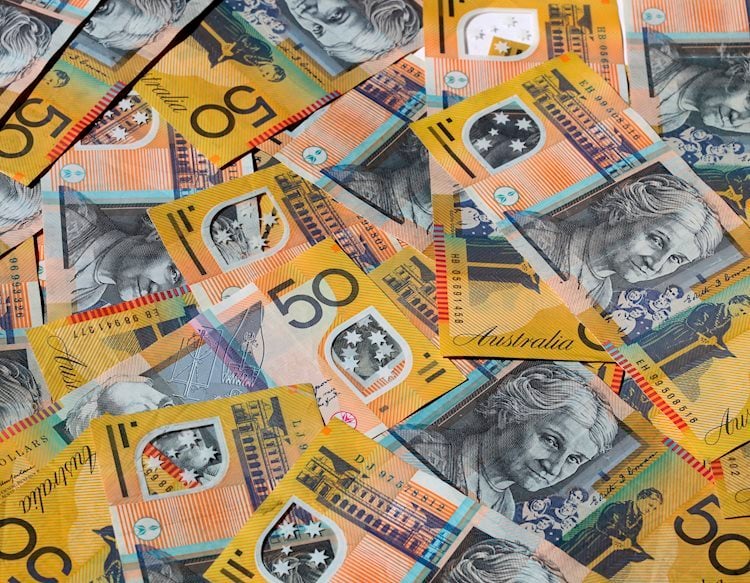- AUD/USD trades with mild losses around 0.6605 in Monday’s early Asian session.
- The US Michigan Consumer Sentiment Index was stronger than expected, rising to 70.5 in October vs. 68.9 prior.
- The hawkish RBA might cap the Aussie’s downside.
The AUD/USD pair remains on the defensive near 0.6605 during the early Asian session on Monday. The downtick of the pair is pressured by the firmer US Dollar (USD) amid the less dovish stance of the Federal Reserve (Fed) and strong University of Michigan (UoM) sentiment data.
The encouraging US economic data could prompt the Fed to adopt a more cautious stance, lifting the Greenback against the Australian Dollar (AUD). Data released on Friday showed that the US Michigan Consumer Sentiment Index rose to 70.5 in October from 68.9 in the previous reading, beating expectations. Meanwhile, the Durable Goods Orders declined by 0.8% MoM in September, above the market consensus of a 1% decline.
Furthermore, the elevated tensions in the Middle East and uncertainty around the US presidential election might boost the safe-haven currency like the USD. Israel’s early Saturday attack on Iran, coordinated with Washington and limited to missile and air defence sites, was more restrained than many thought and could help diplomatic attempts to release prisoners and prevent fighting in Lebanon and Gaza, per Bloomberg. However, Israel’s next steps will probably depend on whether Donald Trump or Kamala Harris wins.
On the other hand, the hawkish remarks from the Reserve Bank of Australia (RBA) could cap the downside for the pair. The RBA is unlikely to cut rates as early as next month. Traders are now pricing in nearly 10% odds of a cut to 4.1% by the RBA on November 5.
Australian Dollar FAQs
One of the most significant factors for the Australian Dollar (AUD) is the level of interest rates set by the Reserve Bank of Australia (RBA). Because Australia is a resource-rich country another key driver is the price of its biggest export, Iron Ore. The health of the Chinese economy, its largest trading partner, is a factor, as well as inflation in Australia, its growth rate and Trade Balance. Market sentiment – whether investors are taking on more risky assets (risk-on) or seeking safe-havens (risk-off) – is also a factor, with risk-on positive for AUD.
The Reserve Bank of Australia (RBA) influences the Australian Dollar (AUD) by setting the level of interest rates that Australian banks can lend to each other. This influences the level of interest rates in the economy as a whole. The main goal of the RBA is to maintain a stable inflation rate of 2-3% by adjusting interest rates up or down. Relatively high interest rates compared to other major central banks support the AUD, and the opposite for relatively low. The RBA can also use quantitative easing and tightening to influence credit conditions, with the former AUD-negative and the latter AUD-positive.
China is Australia’s largest trading partner so the health of the Chinese economy is a major influence on the value of the Australian Dollar (AUD). When the Chinese economy is doing well it purchases more raw materials, goods and services from Australia, lifting demand for the AUD, and pushing up its value. The opposite is the case when the Chinese economy is not growing as fast as expected. Positive or negative surprises in Chinese growth data, therefore, often have a direct impact on the Australian Dollar and its pairs.
Iron Ore is Australia’s largest export, accounting for $118 billion a year according to data from 2021, with China as its primary destination. The price of Iron Ore, therefore, can be a driver of the Australian Dollar. Generally, if the price of Iron Ore rises, AUD also goes up, as aggregate demand for the currency increases. The opposite is the case if the price of Iron Ore falls. Higher Iron Ore prices also tend to result in a greater likelihood of a positive Trade Balance for Australia, which is also positive of the AUD.
The Trade Balance, which is the difference between what a country earns from its exports versus what it pays for its imports, is another factor that can influence the value of the Australian Dollar. If Australia produces highly sought after exports, then its currency will gain in value purely from the surplus demand created from foreign buyers seeking to purchase its exports versus what it spends to purchase imports. Therefore, a positive net Trade Balance strengthens the AUD, with the opposite effect if the Trade Balance is negative.
